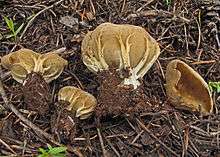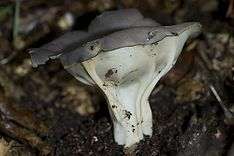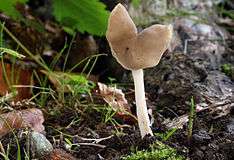Helvella
Helvella is a genus of ascomycete fungus of the family Helvellaceae. The mushrooms, commonly known as elfin saddles, are identified by their irregularly shaped caps, fluted stems, and fuzzy undersurfaces. They are found in North America and in Europe. Well known species include the whitish H. crispa and the grey H. lacunosa. They have been reported to cause gastrointestinal symptoms when eaten raw.[1]
| Helvella | |
|---|---|
 | |
| Helvella crispa | |
| Scientific classification | |
| Kingdom: | |
| Division: | |
| Subdivision: | |
| Class: | |
| Order: | |
| Family: | |
| Genus: | Helvella |
| Type species | |
| Helvella crispa (Scop.) Fr. (1822) | |
Description
Species in Helvella have fruiting bodies (technically ascocarps) that grow above the ground, and usually have stems. The cup-like fruiting body (the apothecium) can assume a variety of forms: it may be shaped like an ear (auriculate), or a saddle; it may be convex or irregularly lobed and bent. The spore-bearing surface, the hymenium, can be smooth, wavy or wrinkled and can range in color from white to black or various shades of gray or brown. Similarly, the outer surface of the fruiting bodies can be smooth, ribbed, or have minute hairlike projections (villi). The stem is cylindrical and tapering or grooved and ribbed. The flesh is usually between 1–2 mm thick.[2]
Species
As of February 2016, Index Fungorum accepts 105 species of Helvella:[3]



- Helvella acetabulum
- Helvella adhaerens
- Helvella aestivalis
- Helvella affinis
- Helvella agaricoides
- Helvella albella
- Helvella albipes
- Helvella arcto-alpina
- Helvella astieri
- Helvella aterrima
- Helvella atra
- Helvella beatonii
- Helvella branzeziana
- Helvella brevis
- Helvella brevissima
- Helvella bulbosa
- Helvella capucinoides
- Helvella chinensis
- Helvella cinerella
- Helvella compressa
- Helvella confusa
- Helvella connivens
- Helvella constricta
- Helvella corbierei
- Helvella corium
- Helvella costifera
- Helvella crassitunicata
- Helvella crispa
- Helvella cupuliformis
- Helvella dissingi
- Helvella dovrensis
- Helvella dryophila[4]
- Helvella dura
- Helvella elastica
- Helvella engleriana
- Helvella ephippioides
- Helvella ephippium
- Helvella faulknerae
- Helvella favrei
- Helvella fibrosa[5]
- Helvella flavida
- Helvella foetida
- Helvella fuegiana
- Helvella fusca
- Helvella galeriformis
- Helvella glutinosa
- Helvella griseoalba
- Helvella hegani
- Helvella helvellula
- Helvella hyperborea
- Helvella javanica
- Helvella jiaohensis
- Helvella jilinensis
- Helvella jimsarica
- Helvella juniperi[6]
- Helvella lactea
- Helvella lacunosa
- Helvella latispora
- Helvella leucomelaena[7]
- Helvella leucopus
- Helvella macropus
- Helvella maculata
- Helvella maroccana
- Helvella menzeliana
- Helvella mesatlantica
- Helvella minor
- Helvella monachella
- Helvella oblongispora
- Helvella pallidula
- Helvella papuensis
- Helvella paraphysitorquata
- Helvella pedunculata
- Helvella pezizoides
- Helvella philonotis
- Helvella phlebophora
- Helvella pileata
- Helvella platycephala
- Helvella platypodia
- Helvella pocillum
- Helvella pulchra
- Helvella quadrisulca
- Helvella queletiana
- Helvella queletii
- Helvella rivularis
- Helvella robusta
- Helvella rossica
- Helvella schaefferi
- Helvella scrobiculata
- Helvella semiobruta
- Helvella sinensis
- Helvella solida
- Helvella solitaria
- Helvella subfusispora
- Helvella subglabra
- Helvella taiyuanensis
- Helvella terrestris[8]
- Helvella ulvinenii
- Helvella umbraculiformis
- Helvella underwoodii
- Helvella unicolor
- Helvella vacini
- Helvella verruculosa
- Helvella vespertina[4]
- Helvella xinjiangensis
- Helvella zhongtiaoensis[9]
See also
References
| Wikimedia Commons has media related to Helvella. |
- Ammirati, Joseph F.; Traquair, James A.; Horgen, Paul A. (1985). Poisonous mushrooms of the northern United States and Canada. Minneapolis: University of Minnesota Press. pp. 259. ISBN 0-8166-1407-5.
- Abbott SP, Currah RS (1997). "The Helvellaceae: systematic revision and occurrence in northern and northwestern North America". Mycotaxon. 62: 1–125.
- Kirk PM. "Species Fungorum (version 29th January 2016). In: Species 2000 & ITIS Catalogue of Life". Retrieved 2016-02-15.
- Nguyen NH, Landeros F, Garibay-Orijel R, Hansen K, Vellinga EC (2013). "The Helvella lacunosa species complex in western North America: cryptic species, misapplied names and parasites". Mycologia. 105 (5): 1275–86. doi:10.3852/12-391. PMID 23709487.
- Korf RP. (2008). "Nomenclatural notes. 12. Untangling hedwig's Octospora villosa: Helvella fibrosa comb. nov". Mycotaxon. 103: 307–12.
- Filippa M, Baiano G (1999). "Helvella juniperi sp. nov. new species collected on the Tyrrhenian coast". Rivista di Micologia (in Italian). 42 (2): 99–118.
- Asef, M.R. (2013) The genus Helvella in Iran. Mycologia Iranica. 1(1). 9-13
- Landvik, Sara; Kristiansen, Roy; Schumacher, Trond (1999). "Pindara: a miniature Helvella". Mycologia. 91 (2): 278–85. doi:10.2307/3761373. JSTOR 3761373.
- Cao JZ, Liu B (1990). "A new species of Helvella from China". Mycologia. 82 (5): 642–43. doi:10.2307/3760054.